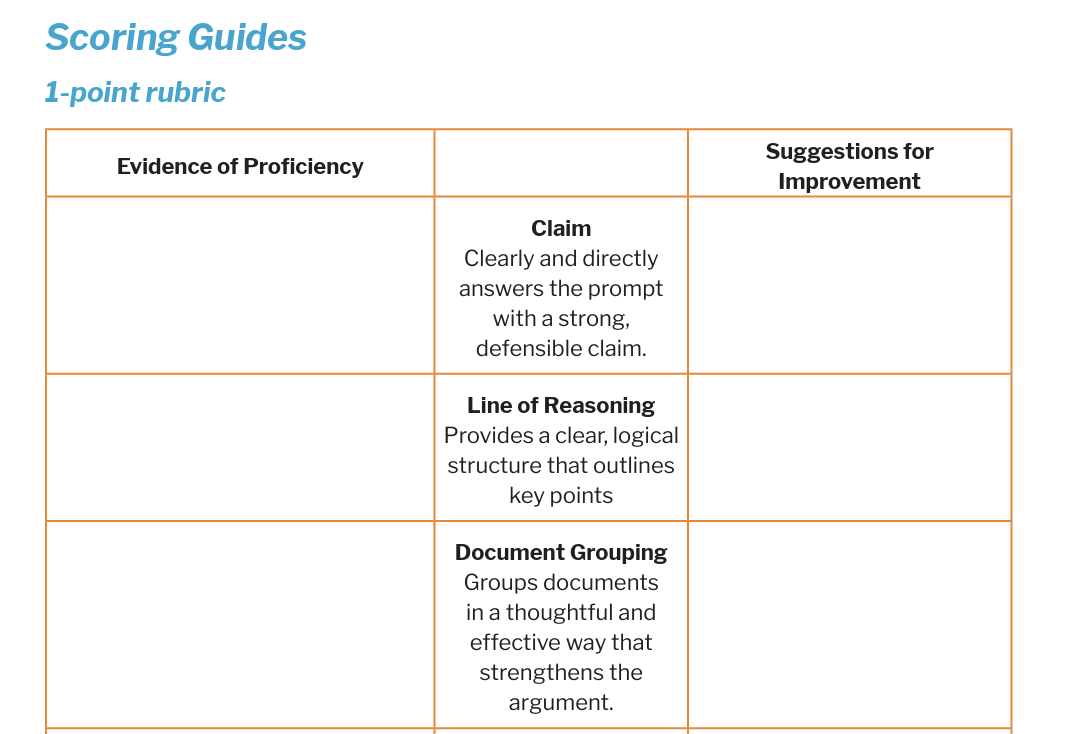Unit 2: American Revolution Model Organizer and Scoring Guide

| Question: How did British and colonial perspectives on taxation, representation, and self-governance compare in the decades leading up to the American Revolution? |
Groups: Answers will vary. A sample answer is provided.
|
Color-Coding- Answers will vary. Sample responses are provided.
|
Graphic Organizer: Answers will vary. A sample response is provided.
|
| Thesis: Answers will vary.
A sample response is provided.
British and colonial perspectives were very different leading up to the Revolutionary War. The American colonists wanted self-governance and believed British taxation was wrong, while the British argued that the colonies had no right to challenge Parliament’s power. |
Scoring Guides
1-point Rubric
| Evidence of Proficiency | Suggestions for Improvement | |
| Claim
Clearly and directly answers the prompt with a strong, defendable claim. |
||
| Line of Reasoning
Provides a clear, logical structure that outlines key points. |
||
| Document Grouping
Groups documents in a thoughtful and effective way that strengthens the argument. |
||
| Use of Evidence
Effectively integrates relevant evidence from documents to support the claim. |
||
| Clarity & Organization
Thesis is clearly written, well-organized, and easy to understand. |
||
| Mechanics & Grammar
Free of errors in grammar, spelling, and punctuation. |
Scoring Matrix
| Criteria | 4 – Advanced | 3 – Proficient | 2 – Developing | 1 – Beginning |
| Claim | Clearly and directly answers the prompt with a strong, defendable claim. | Answers the prompt with a defendable claim. | Partially addresses the prompt with a weak or unclear claim. | Does not address the prompt or lacks a claim. |
| Line of Reasoning | Provides a clear, logical structure that outlines key points. | Establishes a reasonable line of reasoning with some organization. | Attempts a line of reasoning but lacks clarity or coherence. | Does not establish a logical line of reasoning. |
| Document Grouping | Groups documents in a thoughtful and effective way that strengthens the argument. | Groups documents in a logical way that supports the argument | Groups documents, but the connections may be weak or unclear. | Does not group documents or groups them in a way that does not support the argument. |
| Use of Evidence | Effectively integrates relevant evidence from documents to support the claim. | Uses relevant evidence to support the claim. | Uses limited or somewhat relevant evidence. | Does not use evidence or evidence is unrelated. |
| Clarity & Organization | Thesis is clearly written, well-organized, and easy to understand. | Thesis is organized and mostly clear. | Thesis lacks clarity or has issues with organization. | Thesis is unclear and lacks organization. |
| Mechanics & Grammar | Free of errors in grammar, spelling, and punctuation. | Minor errors that do not interfere with the meaning. | Noticeable errors that may distract from the meaning. | Frequent errors that make the thesis difficult to understand. |
Total Score: ____ / 24
Comments: